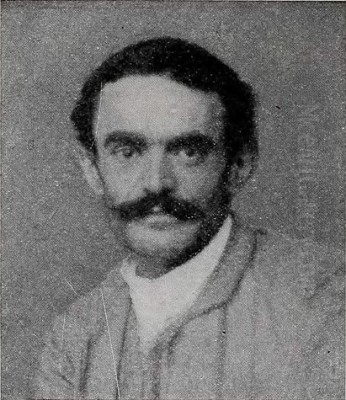
Attilio Pratella stands as a significant figure in Italian art history, particularly renowned for his evocative depictions of Naples and its surrounding beauty. Born in Lugo di Romagna in 1856 and passing away in Naples in 1949, Pratella dedicated much of his long and prolific career to capturing the unique light, atmosphere, and daily life of the Neapolitan region. He became one of the most esteemed painters of the later Neapolitan School, admired for his ability to blend realism with a profound poetic sensibility, making the vibrant energy and scenic vistas of Southern Italy accessible to a wide audience.
His work is characterized by a deep connection to the places he painted, primarily the bustling city of Naples, its picturesque bay, the ever-present Vesuvius, and the charming coastal towns nearby. Pratella was a master of observing and translating the effects of light on water, architecture, and landscapes, often imbuing his canvases with a palpable sense of atmosphere and vibrancy. His legacy endures through his numerous paintings held in museums and private collections, continuing to offer compelling glimpses into the Naples of the late 19th and early 20th centuries.
Early Life and Artistic Formation
Attilio Pratella's journey into the art world began in his birthplace, Lugo di Romagna, in 1856. Recognizing his talent and inclination towards the arts, he pursued formal training at the Academy of Fine Arts in Bologna. His dedication and skill were evident early on, culminating in him winning a prestigious scholarship. This award proved pivotal, enabling him to move to Naples in 1880 to continue his studies at the renowned Naples Academy of Fine Arts (Accademia di Belle Arti di Napoli).
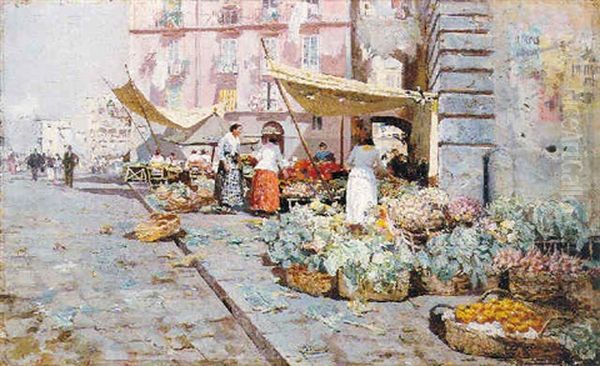
The move to Naples was transformative for Pratella. He found himself immersed in one of Italy's most vibrant artistic centers. The Naples Academy was a hub of creative energy, influenced by leading figures of Italian realism and landscape painting. Here, Pratella would have absorbed the prevailing artistic currents, including the legacy of the Scuola di Posillipo, known for its emphasis on direct observation and capturing the specific light and atmosphere of the Neapolitan landscape. He spent the remainder of his life in Naples, a city that would become not just his home but also his principal muse.
Naples: An Enduring Muse
Naples, with its dramatic coastline, bustling street life, and the iconic silhouette of Mount Vesuvius, offered Pratella an inexhaustible source of inspiration. He was captivated by the city's unique character – the interplay of sunlight on the Tyrrhenian Sea, the vibrant chaos of its markets, the quiet dignity of its fishermen, and the timeless beauty of its ancient palazzi and coastal views. He dedicated his artistic life to exploring these themes, returning again and again to familiar locations like the Bay of Naples, the Mergellina waterfront, Posillipo, and the city's historic center.
Pratella's deep affection for Naples is evident in the sheer volume of work dedicated to the city and its environs. He wasn't merely documenting locations; he was interpreting their spirit. His paintings often convey a sense of immediacy, as if capturing a fleeting moment in time – the shimmer of dawn over the water, the midday heat in a crowded piazza, or the tranquil glow of twilight along the coast. This profound connection to place anchors his work and defines his contribution to Italian landscape painting.
The Neapolitan School and Pratella's Style
Attilio Pratella is firmly associated with the Neapolitan School of painting (Scuola Napoletana), particularly its later developments which absorbed influences from Realism (Verismo) and Impressionism. The earlier Scuola di Posillipo, pioneered by artists like Giacinto Gigante, had already established a tradition of landscape painting focused on capturing the specific light and topography of the Naples area, often working outdoors (en plein air). Pratella built upon this foundation, infusing it with his own sensibilities.
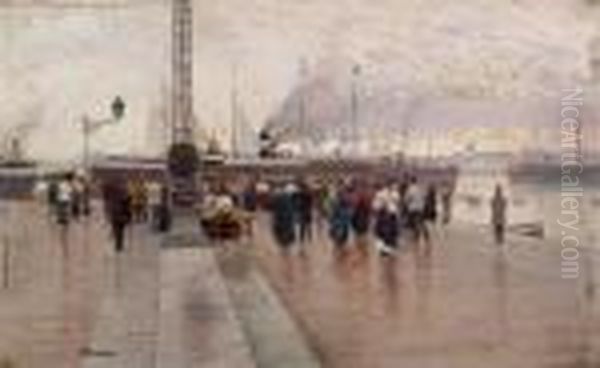
His style is often described as a form of poetic realism. While grounded in accurate observation of nature and urban life, his paintings transcend mere documentation. He possessed a remarkable ability to capture the "vibration" of the atmosphere, using light and color to evoke mood and emotion. His brushwork could be varied, sometimes detailed and precise, other times looser and more suggestive, hinting at the influence of Impressionist techniques in capturing transient effects. He worked diligently outdoors, forming artistic bonds with contemporaries like Gaetano Esposito, with whom he engaged in plein-air painting sessions, seeking to capture the authentic feel of the landscape directly.
Pratella's approach differed from some of his contemporaries. For instance, compared to the sometimes starker realism found in the works of artists like Vincenzo Cinque, who focused intently on the unvarnished reality of everyday life, Pratella often sought a more lyrical interpretation. His paintings, while realistic, frequently emphasize the beauty and picturesque qualities of his subjects, highlighting the interplay of light and color to create harmonious and visually appealing compositions. He was a master of rendering the subtle nuances of the Neapolitan climate – the bright Mediterranean sun, the hazy horizons, and the reflections on the water.
Signature Themes: The Bay, Vesuvius, and City Life
Pratella's oeuvre is dominated by several recurring themes, central to the identity of Naples. The Bay of Naples was perhaps his most beloved subject. He painted it countless times, from panoramic vistas showing the sweep of the coastline towards Sorrento or Capri, to more intimate scenes of fishing boats moored in the harbor or resting on the shores of Mergellina. He captured the bay under different conditions – calm and shimmering under a blue sky, dramatic under gathering storm clouds, or serene in the soft light of dawn or dusk.
Mount Vesuvius frequently appears in his landscapes, often as a majestic backdrop to scenes of the bay or the city. Its iconic profile anchors the compositions and provides a constant reminder of the region's unique geography and history. Pratella depicted it not just as a geological feature but as an integral part of the Neapolitan identity, a silent witness to the life unfolding below.
Beyond the natural landscape, Pratella was equally adept at capturing the vibrant energy of Neapolitan city life. His paintings of markets, such as the famous Pendino Market or depictions of flower markets (Mercato dei fiori a Napoli), are alive with activity. He skillfully rendered the crowds, the colourful stalls, and the specific atmosphere of these bustling urban spaces. Works like Porto di Napoli (Port of Naples) showcase his ability to handle complex scenes involving ships, docks, and the movement of people, all unified by his masterful treatment of light and water.
Representative Works and Artistic Range
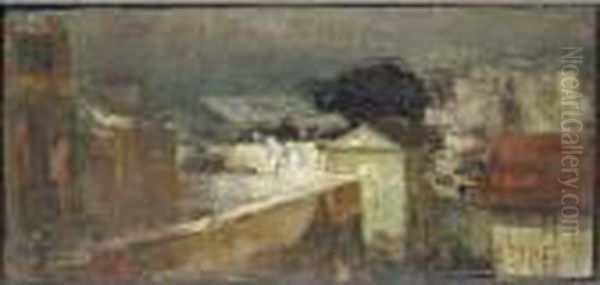
Several works stand out as representative of Attilio Pratella's artistic achievements. The Marketplace (often identified as the Pendino Market) is a recurring subject, showcasing his skill in depicting crowded urban scenes with vibrant energy and attention to detail. These works capture the essence of Neapolitan daily life, filled with vendors, shoppers, and the lively atmosphere characteristic of the city's historic center.
Porto di Napoli (Port of Naples) is another key theme, allowing Pratella to explore his fascination with the sea, boats, and the interplay of light on water within the context of the busy harbor. These paintings often feature meticulous renderings of sailing vessels and steamships alongside the working life of the docks.
Facchini al Palazzo Donn'Anna (Porters at the Donn'Anna Palace) combines landscape with genre painting, depicting workers near the famous seaside ruins at Posillipo. This work is noted for its harmonious composition and careful selection of figures, integrating human activity seamlessly into the coastal setting. It also highlights his interest in the lives of ordinary Neapolitans.
I Bagni Elena a Posillipo provides a fascinating glimpse into leisure activities along the coast during the late 19th century. As noted by observers, such paintings serve as valuable historical documents, capturing scenes before the widespread use of photography, rendered with Pratella's characteristic sensitivity to light and place.
His artistic range extended beyond these core Neapolitan themes. Works like Laguna Veneta (Venetian Lagoon), painted later in his life (1943, tempera), demonstrate his skill in capturing different Italian landscapes, though Naples remained his primary focus. He worked confidently in various media, including oil on canvas or panel, tempera, and gouache, adapting his technique to the subject and desired effect. Other notable titles include Pesca verso Mergellina (Fishing towards Mergellina), Strada presso il Vesuvio (Road near Vesuvius), Notturno (Nocturne), and landscapes simply titled Sesto, further illustrating his dedication to the Neapolitan panorama.
Technique and Artistic Approach
Pratella's commitment to plein-air painting was fundamental to his practice. Working directly from nature allowed him to capture the immediate sensations of light, color, and atmosphere that define his work. This approach, shared with many Impressionists and members of the later Neapolitan School, emphasized spontaneity and direct observation over academic formulas. His canvases often retain a freshness and vibrancy that speaks to this direct engagement with the subject.
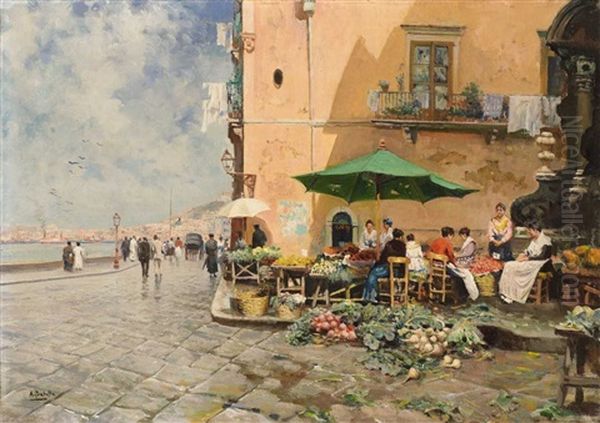
His palette was typically bright and luminous, reflecting the strong Mediterranean light, but he was also capable of capturing more subtle effects, such as the diffused light of an overcast day or the soft glow of twilight. His study of light was paramount, influencing his compositions and color choices. He skillfully used contrasts of light and shadow to create depth and volume, and his rendering of reflections on water was particularly admired.
While influenced by Impressionism, particularly in his attention to light and atmosphere and sometimes looser brushwork, Pratella maintained a strong connection to the realist tradition. His drawing remained solid, and his compositions, while often capturing fleeting moments, were carefully constructed. He achieved a balance between objective representation and subjective interpretation, resulting in works that are both believable and emotionally resonant.
Contemporaries and Artistic Milieu
Attilio Pratella worked during a rich period in Italian art, particularly in Naples. He was part of a generation of artists who navigated the transition from 19th-century academic traditions towards more modern approaches. His contemporaries within the Neapolitan sphere included figures like Edoardo Dalbono, known for his luminous marine paintings, and Francesco Paolo Michetti, whose work often focused on Abruzzese folk life with vibrant realism.
He associated with artists like Gaetano Esposito for outdoor painting excursions. His poetic realism can be seen in relation to, yet distinct from, the work of Vincenzo Cinque. He would have been aware of other prominent Neapolitan painters active during his time, such as the highly individualistic Antonio Mancini, known for his textured portraits, and Vincenzo Irolli, celebrated for his lively genre scenes. The legacy of earlier masters of the Naples Academy, like Domenico Morelli and Filippo Palizzi, who championed realism and landscape, undoubtedly formed part of the artistic environment Pratella inherited and contributed to.
Furthermore, his work can be situated within the broader context of Italian painting, which included movements like the Macchiaioli in Tuscany (with artists such as Giovanni Fattori and Telemaco Signorini) who also emphasized plein-air work and realism. While Pratella's focus remained intensely regional, his engagement with light and modern life connects him to wider European trends, including Impressionism, elements of which are visible in the works of contemporaries like Luca Postiglione and Pietro Scoppettone. Even internationally recognized Italian artists like Giuseppe De Nittis, who hailed from Barletta but achieved fame in Paris, shared an interest in capturing modern life and atmospheric effects, showing parallel developments in Italian art.
Recognition, Collections, and Legacy
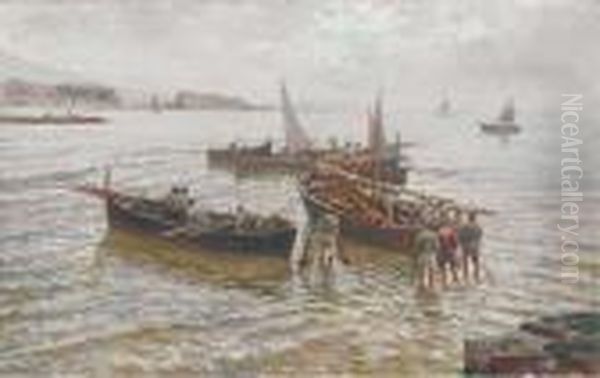
Attilio Pratella achieved considerable recognition during his lifetime. His skill and dedication were formally acknowledged in 1902 when he was appointed an Honorary Professor at the Naples Academy of Fine Arts, the very institution where he had honed his craft. This honor reflected his standing within the Neapolitan artistic community.
His paintings were sought after by collectors and institutions both in Italy and abroad. Today, his works are held in the collections of several important museums, including the Anastasia Simu Museum in Bucharest, Romania, the Gallery of Modern Art (Galleria d'Arte Moderna) in Florence, the Ravenna Art Museum (Museo d'Arte della città di Ravenna), and the Gallery of Modern Art (Galleria d'Arte Moderna) in Milan. Numerous works also remain in private collections, testament to his enduring appeal among art enthusiasts.
The market value of his paintings, as indicated by auction estimates for works like Donn'Anna's Palace Porters (estimated €6,500-€9,500) and Pendino Market (estimated €5,500-€8,500) in past sales, reflects his continued status as a respected and collectible artist. His legacy lies in his consistent and loving portrayal of Naples. He captured the city's soul – its beauty, its energy, its light – with a unique blend of realism and poetry. He remains one of the quintessential painters of Naples, whose work continues to define the visual identity of the region for many.
Conclusion
Attilio Pratella occupies a distinguished place in the history of Italian art as a leading exponent of late Neapolitan landscape and cityscape painting. Over a long career spanning the late 19th and early 20th centuries, he remained devoted to capturing the essence of Naples and its surroundings. His mastery lay in his exceptional sensitivity to light and atmosphere, combined with a realist's eye for detail and a poet's feeling for place.
Through works like Porto di Napoli, The Marketplace, and countless views of the Bay of Naples under the watchful eye of Vesuvius, Pratella created an enduring visual record of his adopted city. He successfully bridged the gap between the established traditions of the Neapolitan School and the emerging influences of Impressionism, forging a style that was both authentic and evocative. His paintings continue to resonate today, offering viewers luminous and heartfelt glimpses into the timeless beauty and vibrant life of Naples.